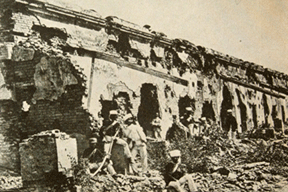 People's Democracy
People's Democracy
(Weekly
Organ of the Communist Party of India (Marxist)
No. 20
May 20, 2007
(Weekly
Organ of the Communist Party of India (Marxist)
|
Vol.
XXXI
No. 20 May 20, 2007 |
Destruction Of Delhi

After the rebel soldiers had established their control over Delhi, and had proclaimed Bahadur Shah as the emperor on May 11, they attempted to set up a new administration in Delhi. Till the end of June 1857 the main person who coordinated these efforts (including the major task of defending the city) was Mirza Mughal who was the eldest surviving son of Bahadur Shah. Subsequently the leadership of the rebels, and of the administration of Delhi, was taken over by Bakht Khan. Bakht Khan arrived in Delhi at the beginning of July. The rebel administration found it increasingly difficult to function because it had hardly any access to resources. Wealthier sections of the city were unwilling to give money to them as they did not have sufficient confidence in the rebel leaders. At the same time the pressure of the British forces increased and the defence of the city became the main priority. The British had meanwhile launched a counter-offensive. On June 6,1857 they had defeated a large force of the rebels at Badli-ki-Sarai, a short distance from Delhi. They had then succeeded in taking over the northern Ridge. The British force numbered around 6500. Throughout the summer months, the British force remained stationed at the Ridge. Then in mid-September 1857 it carried out a major assault to capture the city. From the Ridge the (British) troops moved in the direction of Kashmere Gate. The gate was stormed and taken. The attack was led by John Nicholson who was wounded and died shortly afterwards. By September 20, 1857 the entire city had been taken over and the rebels were defeated. Then began a period of vicious large-scale massacre of the rebels and the ordinary people of Delhi. For about a week the troops killed able-bodied men indiscriminately. It is not possible to estimate the number of people killed in the first six days of the assault, but the number would have been well over ten thousand. Nearly 1400 were massacred in just one mohalla—Kucha Chelan. The main target of course were the remaining rebel soldiers and the inhabitants of the Red Fort. However, sadistic brutality perpetrated on a mass scale as a matter of official policy resulted in the entire population of the Walled City being driven out. The aged and the infirm, who had been unable to join the general exodus, too were evicted from the city by the orders of the military officials. Delhi was literally cleansed of all indigenous inhabitants, barring those who had been incarcerated (Bahadurshah Zafar being one of them). The nearly 3000 prisoners were summarily tried and almost a thousand of these were executed. The banished residents, numbering between eighty thousand and a lakh of people, either fled to the surrounding countryside, or had to spend the cold winter months outside the city walls, without any shelter, warm clothing or food. The main refugee camps were located around Nizamuddin basti and in the Qutab-Mehrauli area. From January 1858 onwards non-Muslim residents of the city were selectively given permission to return to the city. At the beginning of 1858 it was estimated that there were about 50,000 people within the city walls (including a handful of Muslims). Muslims were allowed to return only from January 1859 onwards. Until August 1858 no one was allowed to enter the city without a pass. The total intramural population of the city was around 1,50,000 on the eve of the Revolt; it was less than one lakh in the early 1860s. By the beginning of 1858 colonial officials were discussing various proposals for punishing Delhi. A proposal for razing the entire Walled City to the ground, and erecting a grand memorial on the site, was under serious consideration though eventually abandoned. But large areas of the city were demolished, especially the zone adjoining the Red Fort. All buildings within a radius of 448 sq. yards were levelled (only the Dariba was spared). This meant that the Faiz Bazar (lying between the Fort and the Delhi Gate of the city) was demolished. The fairly densely populated area between the Fort and the Jama Masjid was also destroyed, resulting in large-scale dislocation of the residents of this part of the city—an important centre of Urdu. There was also large-scale confiscation of property, especially property owned by Muslims. Moreover, several prominent Muslims remained under house-arrest for several years after 1857-58